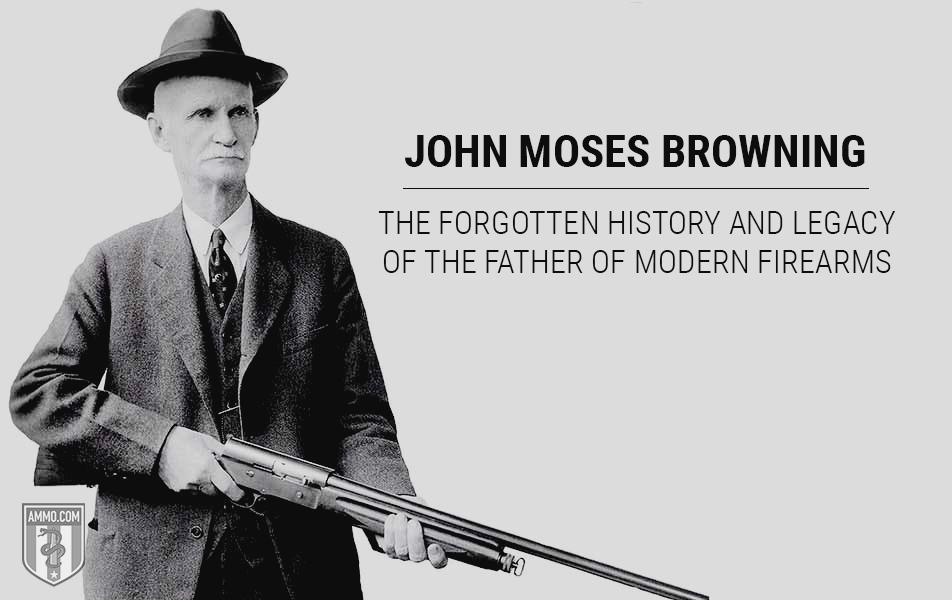John Moses Browning: The Forgotten History and Legacy of the Father of Modern Firearms
You're free to republish or share any of our articles (either in part or in full), which are licensed under a Creative Commons Attribution 4.0 International License. Our only requirement is that you give Ammo.com appropriate credit by linking to the original article. Spread the word; knowledge is power!
 John Moses Browning is known to firearms and Second Amendment enthusiasts primarily as a gunsmith, but he was more than that: He was also an inventor, an innovator, and perhaps one of the most successful firearm designers the world has ever seen. It’s without question that he is the father of modern firearms as we know them. John Browning is arguably the man most responsible for modern firearms, including lever-action, pump-action, and auto-loading weapons.
John Moses Browning is known to firearms and Second Amendment enthusiasts primarily as a gunsmith, but he was more than that: He was also an inventor, an innovator, and perhaps one of the most successful firearm designers the world has ever seen. It’s without question that he is the father of modern firearms as we know them. John Browning is arguably the man most responsible for modern firearms, including lever-action, pump-action, and auto-loading weapons.
Browning was born into a Mormon settler family in Ogden, Utah, on January 23, 1855. His parents, Jonathan Browning and Elizabeth Clark, were Mormons who settled in Utah after the Mormon Exodus of 1847. A gunsmith himself, Jonathan often had young John in the shop alongside him, where the child learned concepts of manufacturing and engineering. The elder Browning also encouraged experimentation. By the age of 11, John had created his first firearm from castaway pieces and took it hunting, providing his family with three prairie chickens for the family’s dinner. By the time he was 18, John Browning had taken over his father’s business.
In the spring of 1879, John married Rachel Teresa Child, who would eventually bear John 10 children, eight of whom survived infancy. On October 7th of that same year, John received the first of his 128 firearm patents, this one for the Browning Single Shot rifle.
In 1880, John recruited his brothers and built what would become known as the Browning Arms Company. Although the business was successful, John was not satisfied. Rather than mass-producing firearms for commercial sale, Browning wanted to revolutionize the entire small arms industry.
John Browning Makes a Deal with Winchester
In 1883, when Winchester Repeating Arms Company made an offer on Browning’s rifle, John sold it for $8,000, (about $200,000 in 2019). Next, Winchester asked Browning to create a lever-action shotgun. Through this experience, Browning learned that a pump-action shotgun would be more effective. This was his next patent for Winchester, in 1888.
Browning continued to work for Winchester until 1902, when royalty payments caused a rift between the two. While working for Winchester, however, Browning created a number of iconic, best-selling weapons, including lever-action rifles and both lever-action and pump-action shotguns. Many are still favorites of the gun-buying public today, including:
- The single-shot Winchester 1885: Still manufactured today, it can be found in various calibers, including .17 Remington, .243, .30-06, and .45-70 Govt, among others.
- The lever-action Winchester 1894: One of the most popular hunting rifles in the U.S., it was originally chambered to fire .32-40 Win and .38-55 Win. It was also the first long gun to use the smokeless powder .30-30 round (originally called the .30 WCF). Other caliber variations include: .32 Win Special, .444 Marlin, .45 Long Colt, .450 Marlin, .357 Mag, .44 Mag, and .410 bore, as well as other less-known cartridges.
- The lever-action Winchester 1895: A popular military and hunting rifle, it was chambered for full-size ammo like 7.62x54mmR, .30-30, .30-06, and .405 Winchester.
- The pump-action Winchester 1897: Also known as a Trench Gun, this shotgun was offered in various barrel lengths and grades, and came chambered in either 12 or 16 gauge. It was manufactured from 1897 through 1957, and over one million were made.
- The bolt-action Winchester 1900: A single-shot rifle, the 1900 was designed for the .22LR, but could also fire .22 Short and .22 Long cartridges.
John Browning Moves to Fabrique Nationale
After his disagreement with Winchester, Browning went to Belgium, the home of Fabrique Nationale de Herstal. There, he created the Browning Auto-5, the first successful semi-automatic shotgun. Recoil-operated, this firearm was one of the best-selling firearms during the 20th century, and remained in production until 1998.
Browning stayed with Fabrique Nationale until his death on November 26, 1926, when he died of heart failure at the age of 71. His work continued until the very day that he died, working with his son, Van, on a new self-loading pistol design.
The last completed gun Browning designed was the Browning Superposed shotgun, the first over-and-under shotgun that was chambered for 12 gauge, 16 gauge, 20 gauge, 28 gauge, and .410 bore.
John Browning’s Military Legacy
In 1905, Browning earned the John Scott Medal, given to inventors who increased the “comfort, welfare, and happiness of humankind.” In 1914, he received the Order of Leopold medal, granting him the Belgian honorary orders of knighthood.
Although his name isn’t as closely related to America’s Wild West as other 19th-century gun manufacturers, such as Samuel Colt and Oliver Winchester, perhaps it should be. Many of their firearms were based on Browning’s designs.
Not only did he invent the lever-action and pump-action long guns, but he designed the first functional gas-operated firearm. While watching a shooting competition, Browning found inspiration in reeds blown aside when gases released from the gun’s muzzle. He set out to use that force in the repeating mechanism. After three years, Browning received a patent for his first automatic-reloading weapon, what would eventually evolve into the Browning Automatic Rifle, the same rifle U.S. soldiers carried into WWI.
Browning also designed what turned into one of the most popular handguns in America, the Colt 1911. Originally made for the military, the M1911 was the standard issue handgun for the U.S. armed forces from 1911 through 1986. As a civilian handgun, it’s now available in significantly more calibers than the original .45 ACP – including 9mm, 10mm, .22LR, .380 ACP, and .38 Super.
Browning created a number of weapons for the military, including:
- FN M1900 single-action, semi-auto pistol in .32 ACP (the first handgun to feature a modern slide)
- Colt 1903 Pocket Hammerless pistol in .32 ACP (the gun is not actually hammerless, but the hammer is completely covered, making it ideal for a CCW)
- Colt 1908 Vest Pocket Pistol in .25 ACP
- M1917 Browning Machine Gun in .30-06 Springfield
- M1919 Browning Machine Gun
- M2 Heavy Machine Gun in .50 BMG
John Moses Browning left a legacy almost as big as the modern firearms industry; since his death, there have been no disruptive developments in gun design. Fundamentally, we’re still using his guns today.
Yet his legacy goes beyond the shooting world. Browning was a modest man, even for his time. He was polite. He was quiet. And although he became a world-famous gunsmith, he still met with the laborers in his factories on the regular and treated them with as much respect as the management.
If you ever find yourself in Ogden, Utah, swing by the John M. Browning Firearms Museum and take a moment to pay homage to one of American’s unsung heroes.
Unsung Heroes
- S.B. Fuller
- Annie Oakley
- Edward Snowden
- Sam Colt
- Davy Crockett
- Susan B. Anthony
- Milton Friedman
- Vaclav Havel
- Charlton Heston
- Sojourner Truth
- Ted Nugent
- Eugene Stoner
- John Garand
- Charles Parker
- Oliver Winchester
- Charles Newton
- Lysander Spooner
- John Moses Browning
- Butch O'Hare
- Georg Luger
- Elmer Keith
- Benjamin Tyler Henry
- Ron Paul
- Witold Pilecki
- Roof Koreans
- Belle Starr
- Carlos Hathcock
